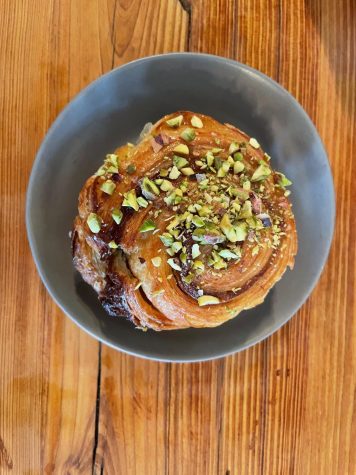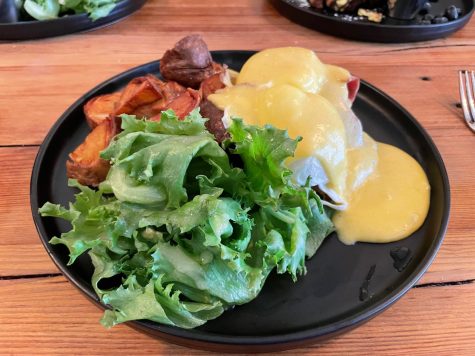Review: Breakfast at The Break Room
February 15, 2023

In the spirit of further expanding our coverage of the local community, the Record is bringing back its food review column. This week, the Record reviewed breakfast and lunch options at The Break Room, located in North Adams’ Greylock WORKS building.
On a frigid February morning, we and a friend, Hannah Yoon ’25, journeyed out to Greylock WORKS — a repurposed cotton-spinning mill — in search of a hearty brunch. Bundled in three layers of clothing and unsure if we had found the correct place, we entered through a door replete with an industrial lock and minimal signage. What we found on the other side was a a lively restaurant brimming with customers hoping to secure seats during the brunch rush.
Led by a team of three chefs — Cynthia Walton, Brian Alberg, and Amanda Perreault — The Break Room describes itself as a restaurant that seeks to highlight ethnic and regional cusines. According to its website, The Break Room is committed to creating sustainable food, sourcing its ingredients from local businesses and agriculture while recycling waste through community programs.
Upon entering Greylock WORKS, guests are greeted with high ceilings and concrete walls in a naturally sunlit and unassuming space that hosts the Berkshire Cider Project and The Distillery. In contrast to its industrial surroundings, The Break Room’s atmosphere is warm and inviting. Embracing the former mill’s aesthetic, tables sit below hanging lightbulbs against an exposed brick wall. Frosted windows with a painted wood frame adorn the other plain white walls to maintain the repurposed factory ambience. The big band jazz music and the open-kitchen layout, featuring a pastry case and two chefs behind the counter working merrily to complete orders, contributed to the warm environment when we entered.
Guests are encouraged to order at the front counter then seat themselves wherever they see fit. When we first ordered, we were told that there would be a 50-minute wait for food and were almost disheartened enough to leave. The food arrived a merciful 22 minutes later — a welcome surprise. After grabbing the first table available, we started off our dining experience with coffee, strawberry lemonade, and a pistachio danish.
The drip coffee was tart and acidic, but it is a fair brew at $2.75 a cup. The strawberry lemonade tasted freshly made, albeit a bit bitter. Like at many restaurants, more than half of the drink was the ice put into the cup, but regardless, it was a refreshing and enjoyable way to start off the meal. The pistachio danish, at $3.50, was a creative interpretation of the classic pastry; layers of perfectly baked flakey dough garnished with chopped pistachios filled with a pistachio frangipane. We split the satisfying, delicious pastry among three people.
Unlike The Break Room’s dinner menus, which feature diverse dishes ranging from falafel sandwiches to beef bourguignon, the breakfast and lunch menus were more traditional. Beyond pastries, the menu offers dishes like French toast and egg-based dishes. For lunch, there are also sandwiches, soups, and salads. We settled on the $22 eggs Benedict and the $18 Alberg sandwich.

The eggs Benedict was divine. Yet at $22 it is no ordinary breakfast, even by weekend standards — especially when compared to versions of the dish that cost $15 at The Barn or $11 at Renee’s Diner and Chef’s Hat. And so a higher standard must be placed on the sides, namely the salad and home fries, which stand to differentiate it. Unfortunately, they did not substantially do so.
Do not let the immediate plainness of The Break Room’s hollandaise dismay you. It offers the perfect combination of richness and flavor to balance perfectly poached eggs and well-flavored ham. The eggs Benedict, as the main dish, was clearly the star of the chock-full plate. The home fries and salad, sadly left more to be desired. The home fries, unadorned with onions or peppers, were crispy, under-salted potatoes that benefited greatly from some hollandaise leftovers. Other elements could have been used to elevate the dish. Likewise the salad was fine, however, it was only greens (the same type of lettuce found at College dining halls) coated with a vinaigrette. Unlike the Alberg’s salad, it did not have carrots or radish.
When the Alberg arrived, the plate seemed a tad crowded. As described in the menu, the Alberg is a pressed corned beef Reuben with crimson kraut, Russian dressing, and Swiss cheese. It is served with a side of house fries and “lemony greens.” These house fries were well-cooked and crispy, as we hoped. The Russian dressing on the side served as a nice dip for the potatoes and an alternative to the typical ketchup. The greens were, in a word, unnecessary — though a nice touch of vegetables and a way to fill up space on the plate, they didn’t add much to the dish flavor-wise. The lemon flavor was clear, but again, the dish in its entirety was filling to a point where we left the salad unfinished on the plate.
Now to the main star of the dish: the sandwich. Since we are both from New York (state), our knowledge of “Reuben” consists of a sandwich using rye bread. The Break Room’s sandwich was held together by a wrap of sorts, which was confusing and frankly a hindrance to the dish. The meat-to-kraut ratio was not ideal either — a little too much corned beef and not enough kraut. Moreover, the sauce would have been better inside the sandwich itself rather than as an optional accompaniment. Overall, the dish did not do the classic Reuben justice.
Overall, The Break Room offers an interesting respite from the College’s dining halls. Its pastries are excellent — so much so that Spoon on Spring Street sources their pastries from it — and the ambiance is a wonderful work environment for anyone who has the means to get there. We wouldn’t necessarily come back for the breakfast given its price point for relatively standard items and the lack of table service. Even so, its dinner menu looks very intriguing, offering dishes more in keeping with the restaurant’s “ethnic and regional” emphasis and at understandable price points.







